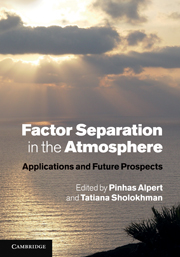Book contents
- Frontmatter
- Contents
- List of contributors
- Foreword
- Preface
- 1 Introduction
- 2 The Factor Separation Methodology and the fractional approach
- 3 Investigation of the Factor Separation features for basic mathematical functions
- 4 Factor Separation Methodology and paleoclimates
- 5 Meso-meteorology: Factor Separation examples in atmospheric meso-scale motions
- 6 Using the Alpert–Stein Factor Separation Methodology for land-use land-cover change impacts on weather and climate process with the Regional Atmospheric Modeling System
- 7 Application of Factor Separation to heavy rainfall and cyclogenesis: Mediterranean examples
- 8 Experience in applying the Alpert–Stein Factor Separation Methodology to assessing urban land-use and aerosol impacts on precipitation
- 9 Free and forced thermocline oscillations in Lake Tanganyika
- 10 Application of the Factor Separation Methodology to quantify the effect of waste heat, vapor and pollution on cumulus convection
- 11 The use of the Alpert–Stein Factor Separation Methodology for climate variable interaction studies in hydrological land surface models and crop yield models
- 12 Linear model for the sea breeze
- 13 Experience and conclusions from the Alpert–Stein Factor Separation Methodology
- 14 Tagging systematic errors arising from different components of dynamics and physics in forecast models
- 15 Some difficulties and prospects
- 16 Summary
- Appendix: References employing the Alpert–Stein Factor Separation Methodology
- References
- Index
13 - Experience and conclusions from the Alpert–Stein Factor Separation Methodology
Ensemble data assimilation and forecasting applications
Published online by Cambridge University Press: 03 May 2011
- Frontmatter
- Contents
- List of contributors
- Foreword
- Preface
- 1 Introduction
- 2 The Factor Separation Methodology and the fractional approach
- 3 Investigation of the Factor Separation features for basic mathematical functions
- 4 Factor Separation Methodology and paleoclimates
- 5 Meso-meteorology: Factor Separation examples in atmospheric meso-scale motions
- 6 Using the Alpert–Stein Factor Separation Methodology for land-use land-cover change impacts on weather and climate process with the Regional Atmospheric Modeling System
- 7 Application of Factor Separation to heavy rainfall and cyclogenesis: Mediterranean examples
- 8 Experience in applying the Alpert–Stein Factor Separation Methodology to assessing urban land-use and aerosol impacts on precipitation
- 9 Free and forced thermocline oscillations in Lake Tanganyika
- 10 Application of the Factor Separation Methodology to quantify the effect of waste heat, vapor and pollution on cumulus convection
- 11 The use of the Alpert–Stein Factor Separation Methodology for climate variable interaction studies in hydrological land surface models and crop yield models
- 12 Linear model for the sea breeze
- 13 Experience and conclusions from the Alpert–Stein Factor Separation Methodology
- 14 Tagging systematic errors arising from different components of dynamics and physics in forecast models
- 15 Some difficulties and prospects
- 16 Summary
- Appendix: References employing the Alpert–Stein Factor Separation Methodology
- References
- Index
Summary
A long-term goal of our work is to find an efficient system for probabilistic planetary boundary layer (PBL) very short-range forecasting (nowcasting) that can be employed wherever surface observations are present. Our approach makes use of a single column model (SCM) to predict the state of a PBL column, and an ensemble filter (EF) to assimilate surface observations. Although the system may be run under different levels of complexity it is not immediately clear that the additional complexity will improve the performance of a PBL ensemble system based on a simple model. We address this question in the frame of Alpert–Stein Factor Separation Methodology (ASFSM) analysis with regard to treatment of parameterized radiation, horizontal advection and assimilation of surface observations. Results show that the added complexity often improves the forecasts under most skill metrics, but that assimilation of surface observations is the most important contributor to improved skill.
Introduction
Successful nowcasting and forecasting of the state of the PBL is of value for a wide range of practical forecasting applications, and the aim of this work is to find an efficient method for probabilistic nowcasting (0–3 h forecasting) of the state of the PBL wherever surface observations are available. Convective initiation and forecasted precipitation have shown sensitivity to the PBL structure (Crook 1996; McCaul and Cohen, 2002; Martin and Xue, 2006). Air-quality analysis and plume dispersion can benefit from accurate PBL analysis of stability and mixing depth (e.g., Kumar and Russel, 1996; Shafran et al., 2000).
- Type
- Chapter
- Information
- Factor Separation in the AtmosphereApplications and Future Prospects, pp. 196 - 218Publisher: Cambridge University PressPrint publication year: 2011



